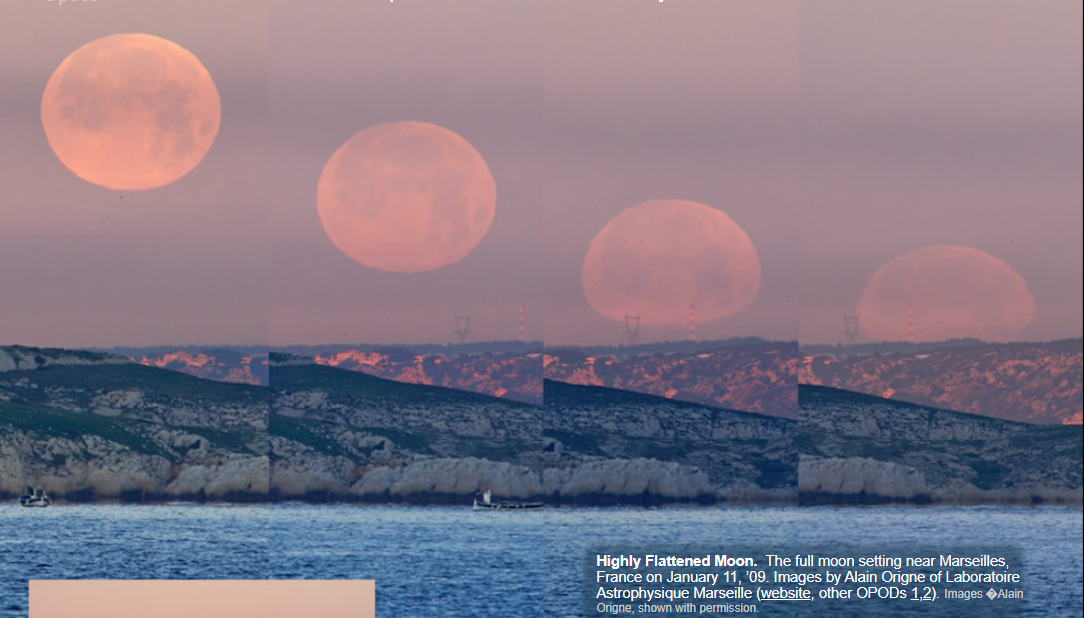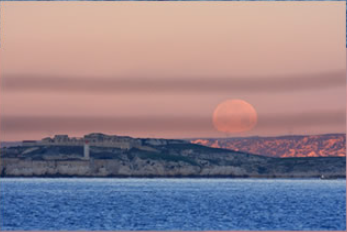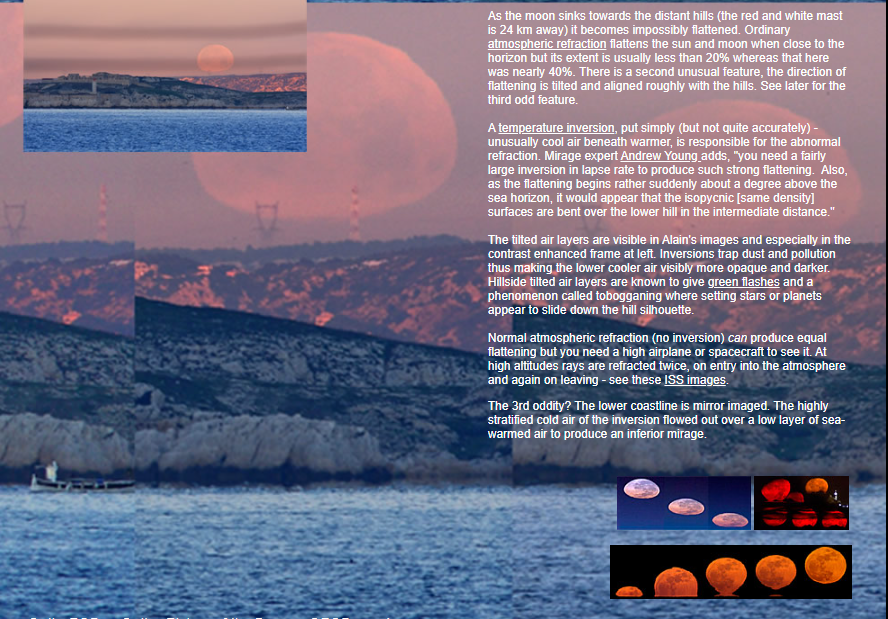Flattened Moon
Flattened Moon: An Unusual Atmospheric Optics Phenomenon
Have you ever witnessed a flattened moon near the horizon and wondered what causes this peculiar optical illusion? The phenomenon of a flattened moon occurs when the moon appears impossibly compressed as it sinks towards the distant hills. While ordinary atmospheric refraction can flatten the sun and moon to some extent, the degree of flattening observed in certain instances can be truly remarkable, reaching nearly 40% as opposed to the usual 20%. In this article, we will explore the factors behind this phenomenon and delve into the fascinating details that contribute to its unique appearance.
The Role of Atmospheric Refraction and Temperature Inversions
Ordinary atmospheric refraction, which is the bending of light as it passes through Earth's atmosphere, is primarily responsible for the flattening of celestial objects near the horizon. However, to achieve the significant degree of flattening observed in a flattened moon, additional factors come into play. One crucial factor is the presence of a temperature inversion.
A temperature inversion occurs when a layer of cool air is trapped beneath a layer of warmer air. This inversion in temperature leads to abnormal refraction, amplifying the flattening effect on celestial objects. Mirage expert Andrew Young explains that a fairly large inversion in lapse rate is required to produce such strong flattening. In the case of the flattened moon near Marseilles, France, on January 11, '09, the sudden onset of flattening about a degree above the sea horizon indicates that the isopycnic (same density) surfaces are bent over the lower hill in the intermediate distance.
Tilted Air Layers and Optical Phenomena
When observing images of the flattened moon, you may notice distinct tilted air layers visible in the photographs. These tilted air layers are a result of the temperature inversion and are often associated with intriguing optical phenomena. Inversions tend to trap dust and pollution, making the lower, cooler air visibly more opaque and darker. This effect can create hillside tilted air layers that give rise to phenomena such as green flashes and a fascinating phenomenon called "tobogganing." Tobogganing occurs when setting stars or planets appear to slide down the silhouette of a hill.
High Altitude Perspective: Refraction from Above
Ordinary atmospheric refraction, without the presence of a temperature inversion, can still produce some degree of flattening. However, this is typically only observable from high altitudes, such as in airplanes or spacecraft. At these heights, rays of light experience refraction twice—once upon entry into the atmosphere and again upon leaving. Images captured from the International Space Station (ISS) provide a unique perspective on this phenomenon, showcasing the equal flattening of celestial objects from a higher vantage point.
The Mirror Image Effect: Inferior Mirages
In addition to the striking flattening effect, another intriguing aspect of the flattened moon near Marseilles is the presence of a mirror image along the lower coastline. This mirror image is the result of a highly stratified cold air layer from the inversion flowing over a lower layer of sea-warmed air, creating what is known as an inferior mirage. Inferior mirages occur when light rays are refracted in such a way that they create an illusionary reflection below the actual object, often appearing inverted or distorted.
Conclusion
The flattened moon is a captivating atmospheric optics phenomenon that showcases the interplay between atmospheric refraction and temperature inversions. When observed near the horizon, the moon can appear significantly flattened, with a degree of compression that exceeds what is typically observed. Tilted air layers resulting from temperature inversions contribute to the visual spectacle, creating optical phenomena like green flashes and tobogganing. While ordinary atmospheric refraction can also cause some flattening, it is usually only visible from high altitudes. Finally, the presence of a mirror image along the lower coastline adds another layer of intrigue, resulting from the interaction between cold air layers and warmer sea air. The flattened moon serves as a reminder of the wonders and complexities of our atmosphere, continually surprising us with its optical illusions.

Highly Flattened Moon. The full moon setting near Marseilles, France on January 11, ’09. Images by Alain Origne of Laboratoire Astrophysique Marseille (website, other OPODs 1,2). Images �Alain Origne, shown with permission.

As the moon sinks towards the distant hills (the red and white mast is 24 km away) it becomes impossibly flattened. Ordinary atmospheric refraction flattens the sun and moon when close to the horizon but its extent is usually less than 20% whereas that here was nearly 40%. There is a second unusual feature, the direction of flattening is tilted and aligned roughly with the hills. See later for the third odd feature.
A temperature inversion, put simply (but not quite accurately) - unusually cool air beneath warmer, is responsible for the abnormal refraction. Mirage expert Andrew Young adds, "you need a fairly large inversion in lapse rate to produce such strong flattening. Also, as the flattening begins rather suddenly about a degree above the sea horizon, it would appear that the isopycnic .same density. surfaces are bent over the lower hill in the intermediate distance."
The tilted air layers are visible in Alain's images and especially in the contrast enhanced frame at left. Inversions trap dust and pollution thus making the lower cooler air visibly more opaque and darker. Hillside tilted air layers are known to give green flashes and a phenomenon called tobogganing where setting stars or planets appear to slide down the hill silhouette.
Normal atmospheric refraction (no inversion) can produce equal flattening but you need a high airplane or spacecraft to see it. At high altitudes rays are refracted twice, on entry into the atmosphere and again on leaving - see these ISS images.
The 3rd oddity? The lower coastline is mirror imaged. The highly stratified cold air of the inversion flowed out over a low layer of sea-warmed air to produce an inferior mirage.

Note: this article has been automatically converted from the old site and may not appear as intended. You can find the original article here.
Reference Atmospheric Optics
If you use any of the definitions, information, or data presented on Atmospheric Optics, please copy the link or reference below to properly credit us as the reference source. Thank you!
-
<a href="https://atoptics.co.uk/blog/flattened-moon/">Flattened Moon</a>
-
"Flattened Moon". Atmospheric Optics. Accessed on April 19, 2024. https://atoptics.co.uk/blog/flattened-moon/.
-
"Flattened Moon". Atmospheric Optics, https://atoptics.co.uk/blog/flattened-moon/. Accessed 19 April, 2024
-
Flattened Moon. Atmospheric Optics. Retrieved from https://atoptics.co.uk/blog/flattened-moon/.